Report on Leadership and Management at Ford Vietnam Company - NEU
VerifiedAdded on 2022/04/18
|9
|2535
|61
Report
AI Summary
This report, prepared for the Human Resource Manager at Ford Vietnam, analyzes the roles of leaders and managers within the company, focusing on the application of leadership and management principles in the context of Ford Vietnam's operations. The report begins by differentiating between the roles and characteristics of leaders and managers, supported by relevant management and leadership theories. It then examines how Mr. Quang, the Production Manager, applies these roles and functions, evaluating his leadership approaches using situational, contingency, and systems leadership theories. The report assesses the strengths and weaknesses of these approaches, recommending suitable leadership styles for Mr. Quang to enhance employee engagement and overall company performance. The analysis is based on the provided scenario, which highlights the company's democratic management style, team-based structure, and employee empowerment initiatives, as well as employee feedback regarding leadership styles. The report aims to provide actionable recommendations to improve leadership effectiveness and foster a more productive work environment at Ford Vietnam.
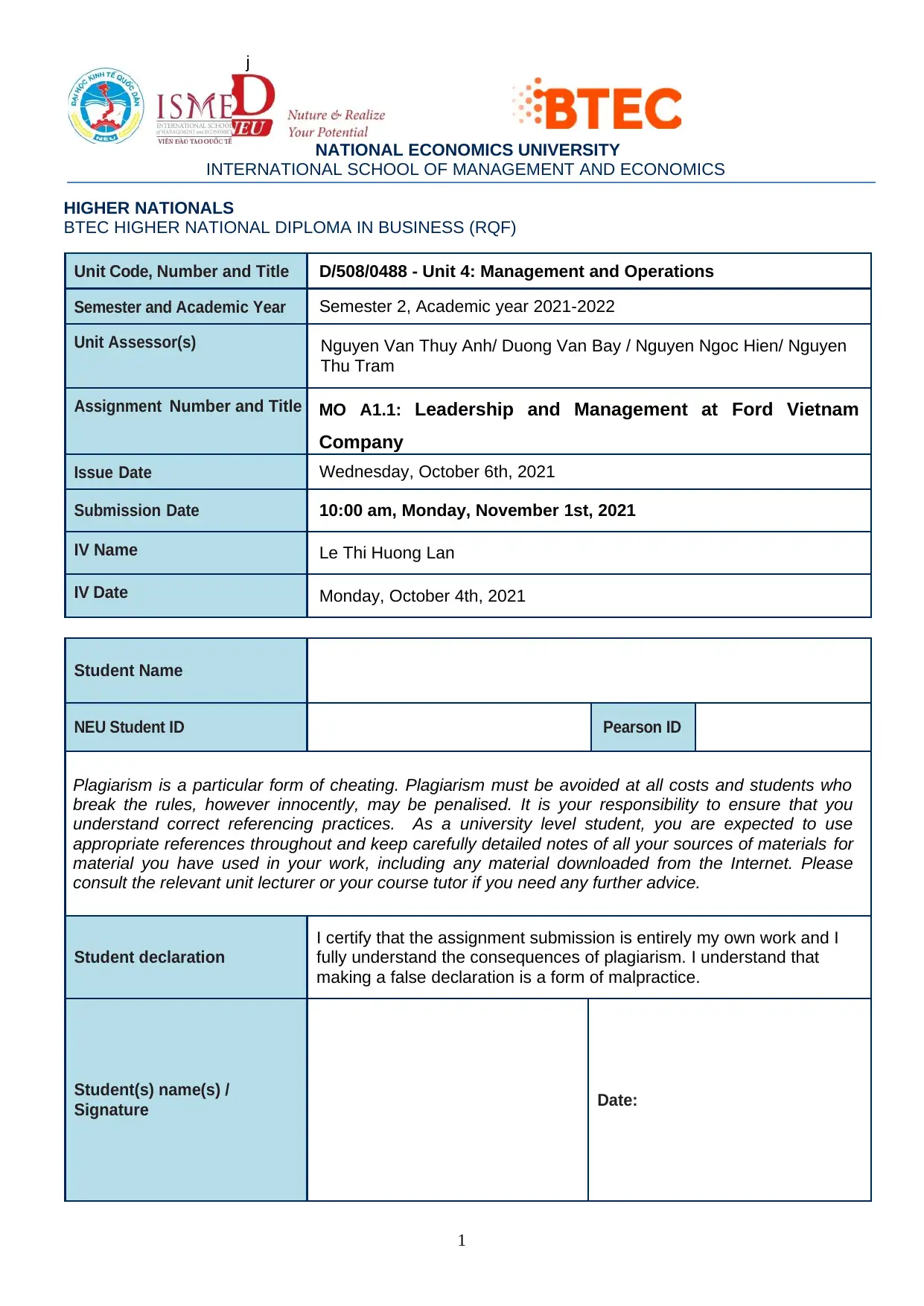
j
NATIONAL ECONOMICS UNIVERSITY
INTERNATIONAL SCHOOL OF MANAGEMENT AND ECONOMICS
HIGHER NATIONALS
BTEC HIGHER NATIONAL DIPLOMA IN BUSINESS (RQF)
Unit Code, Number and Title D/508/0488 - Unit 4: Management and Operations
Semester and Academic Year Semester 2, Academic year 2021-2022
Unit Assessor(s) Nguyen Van Thuy Anh/ Duong Van Bay / Nguyen Ngoc Hien/ Nguyen
Thu Tram
Assignment Number and Title MO A1.1: Leadership and Management at Ford Vietnam
Company
Issue Date Wednesday, October 6th, 2021
Submission Date 10:00 am, Monday, November 1st, 2021
IV Name Le Thi Huong Lan
IV Date Monday, October 4th, 2021
Student Name
NEU Student ID Pearson ID
Plagiarism is a particular form of cheating. Plagiarism must be avoided at all costs and students who
break the rules, however innocently, may be penalised. It is your responsibility to ensure that you
understand correct referencing practices. As a university level student, you are expected to use
appropriate references throughout and keep carefully detailed notes of all your sources of materials for
material you have used in your work, including any material downloaded from the Internet. Please
consult the relevant unit lecturer or your course tutor if you need any further advice.
Student declaration
I certify that the assignment submission is entirely my own work and I
fully understand the consequences of plagiarism. I understand that
making a false declaration is a form of malpractice.
Student(s) name(s) /
Signature Date:
1
NATIONAL ECONOMICS UNIVERSITY
INTERNATIONAL SCHOOL OF MANAGEMENT AND ECONOMICS
HIGHER NATIONALS
BTEC HIGHER NATIONAL DIPLOMA IN BUSINESS (RQF)
Unit Code, Number and Title D/508/0488 - Unit 4: Management and Operations
Semester and Academic Year Semester 2, Academic year 2021-2022
Unit Assessor(s) Nguyen Van Thuy Anh/ Duong Van Bay / Nguyen Ngoc Hien/ Nguyen
Thu Tram
Assignment Number and Title MO A1.1: Leadership and Management at Ford Vietnam
Company
Issue Date Wednesday, October 6th, 2021
Submission Date 10:00 am, Monday, November 1st, 2021
IV Name Le Thi Huong Lan
IV Date Monday, October 4th, 2021
Student Name
NEU Student ID Pearson ID
Plagiarism is a particular form of cheating. Plagiarism must be avoided at all costs and students who
break the rules, however innocently, may be penalised. It is your responsibility to ensure that you
understand correct referencing practices. As a university level student, you are expected to use
appropriate references throughout and keep carefully detailed notes of all your sources of materials for
material you have used in your work, including any material downloaded from the Internet. Please
consult the relevant unit lecturer or your course tutor if you need any further advice.
Student declaration
I certify that the assignment submission is entirely my own work and I
fully understand the consequences of plagiarism. I understand that
making a false declaration is a form of malpractice.
Student(s) name(s) /
Signature Date:
1
Paraphrase This Document
Need a fresh take? Get an instant paraphrase of this document with our AI Paraphraser
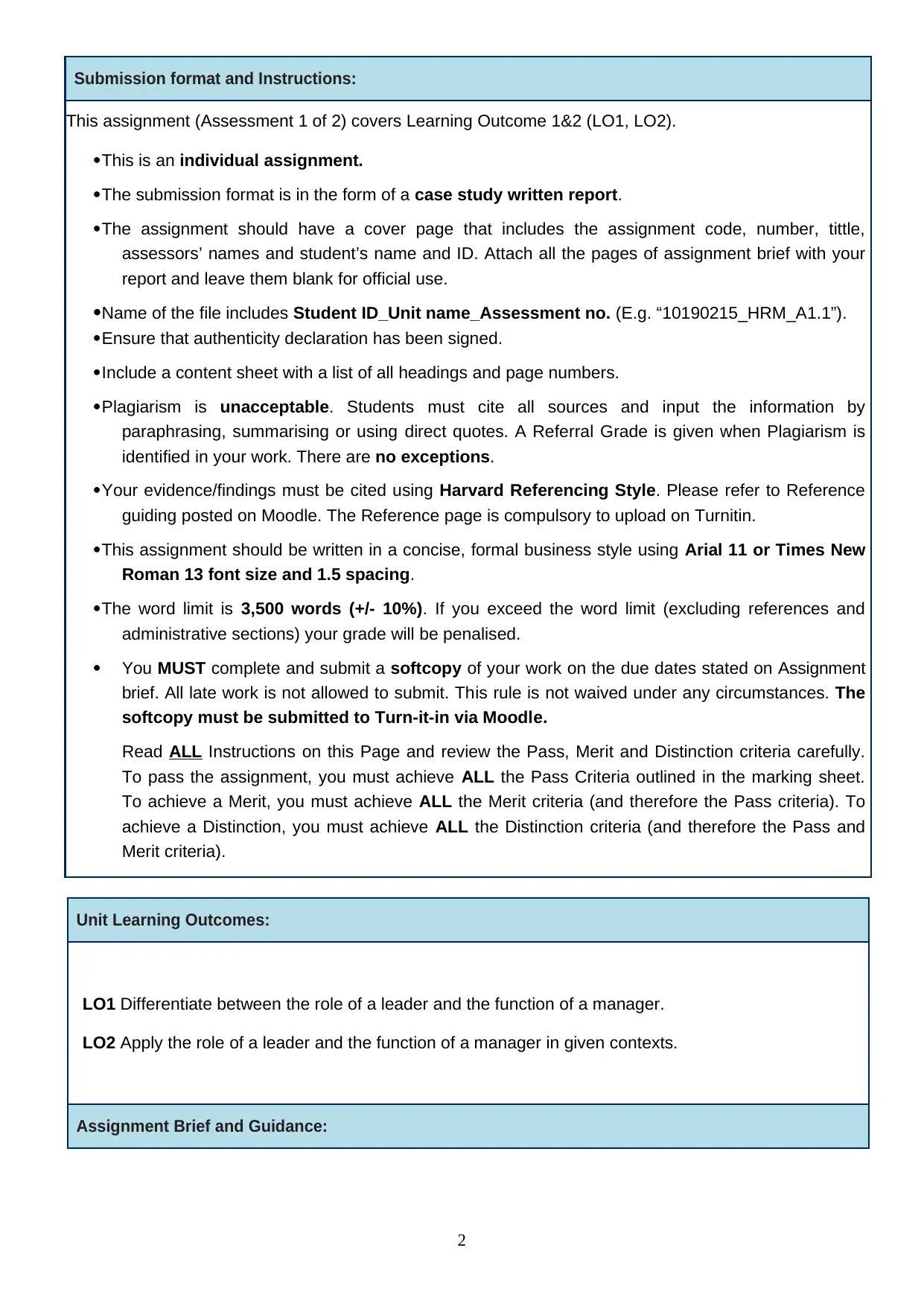
Submission format and Instructions:
This assignment (Assessment 1 of 2) covers Learning Outcome 1&2 (LO1, LO2).
This is an individual assignment.
The submission format is in the form of a case study written report.
The assignment should have a cover page that includes the assignment code, number, tittle,
assessors’ names and student’s name and ID. Attach all the pages of assignment brief with your
report and leave them blank for official use.
Name of the file includes Student ID_Unit name_Assessment no. (E.g. “10190215_HRM_A1.1”).
Ensure that authenticity declaration has been signed.
Include a content sheet with a list of all headings and page numbers.
Plagiarism is unacceptable. Students must cite all sources and input the information by
paraphrasing, summarising or using direct quotes. A Referral Grade is given when Plagiarism is
identified in your work. There are no exceptions.
Your evidence/findings must be cited using Harvard Referencing Style. Please refer to Reference
guiding posted on Moodle. The Reference page is compulsory to upload on Turnitin.
This assignment should be written in a concise, formal business style using Arial 11 or Times New
Roman 13 font size and 1.5 spacing.
The word limit is 3,500 words (+/- 10%). If you exceed the word limit (excluding references and
administrative sections) your grade will be penalised.
You MUST complete and submit a softcopy of your work on the due dates stated on Assignment
brief. All late work is not allowed to submit. This rule is not waived under any circumstances. The
softcopy must be submitted to Turn-it-in via Moodle.
Read ALL Instructions on this Page and review the Pass, Merit and Distinction criteria carefully.
To pass the assignment, you must achieve ALL the Pass Criteria outlined in the marking sheet.
To achieve a Merit, you must achieve ALL the Merit criteria (and therefore the Pass criteria). To
achieve a Distinction, you must achieve ALL the Distinction criteria (and therefore the Pass and
Merit criteria).
Unit Learning Outcomes:
LO1 Differentiate between the role of a leader and the function of a manager.
LO2 Apply the role of a leader and the function of a manager in given contexts.
Assignment Brief and Guidance:
2
This assignment (Assessment 1 of 2) covers Learning Outcome 1&2 (LO1, LO2).
This is an individual assignment.
The submission format is in the form of a case study written report.
The assignment should have a cover page that includes the assignment code, number, tittle,
assessors’ names and student’s name and ID. Attach all the pages of assignment brief with your
report and leave them blank for official use.
Name of the file includes Student ID_Unit name_Assessment no. (E.g. “10190215_HRM_A1.1”).
Ensure that authenticity declaration has been signed.
Include a content sheet with a list of all headings and page numbers.
Plagiarism is unacceptable. Students must cite all sources and input the information by
paraphrasing, summarising or using direct quotes. A Referral Grade is given when Plagiarism is
identified in your work. There are no exceptions.
Your evidence/findings must be cited using Harvard Referencing Style. Please refer to Reference
guiding posted on Moodle. The Reference page is compulsory to upload on Turnitin.
This assignment should be written in a concise, formal business style using Arial 11 or Times New
Roman 13 font size and 1.5 spacing.
The word limit is 3,500 words (+/- 10%). If you exceed the word limit (excluding references and
administrative sections) your grade will be penalised.
You MUST complete and submit a softcopy of your work on the due dates stated on Assignment
brief. All late work is not allowed to submit. This rule is not waived under any circumstances. The
softcopy must be submitted to Turn-it-in via Moodle.
Read ALL Instructions on this Page and review the Pass, Merit and Distinction criteria carefully.
To pass the assignment, you must achieve ALL the Pass Criteria outlined in the marking sheet.
To achieve a Merit, you must achieve ALL the Merit criteria (and therefore the Pass criteria). To
achieve a Distinction, you must achieve ALL the Distinction criteria (and therefore the Pass and
Merit criteria).
Unit Learning Outcomes:
LO1 Differentiate between the role of a leader and the function of a manager.
LO2 Apply the role of a leader and the function of a manager in given contexts.
Assignment Brief and Guidance:
2
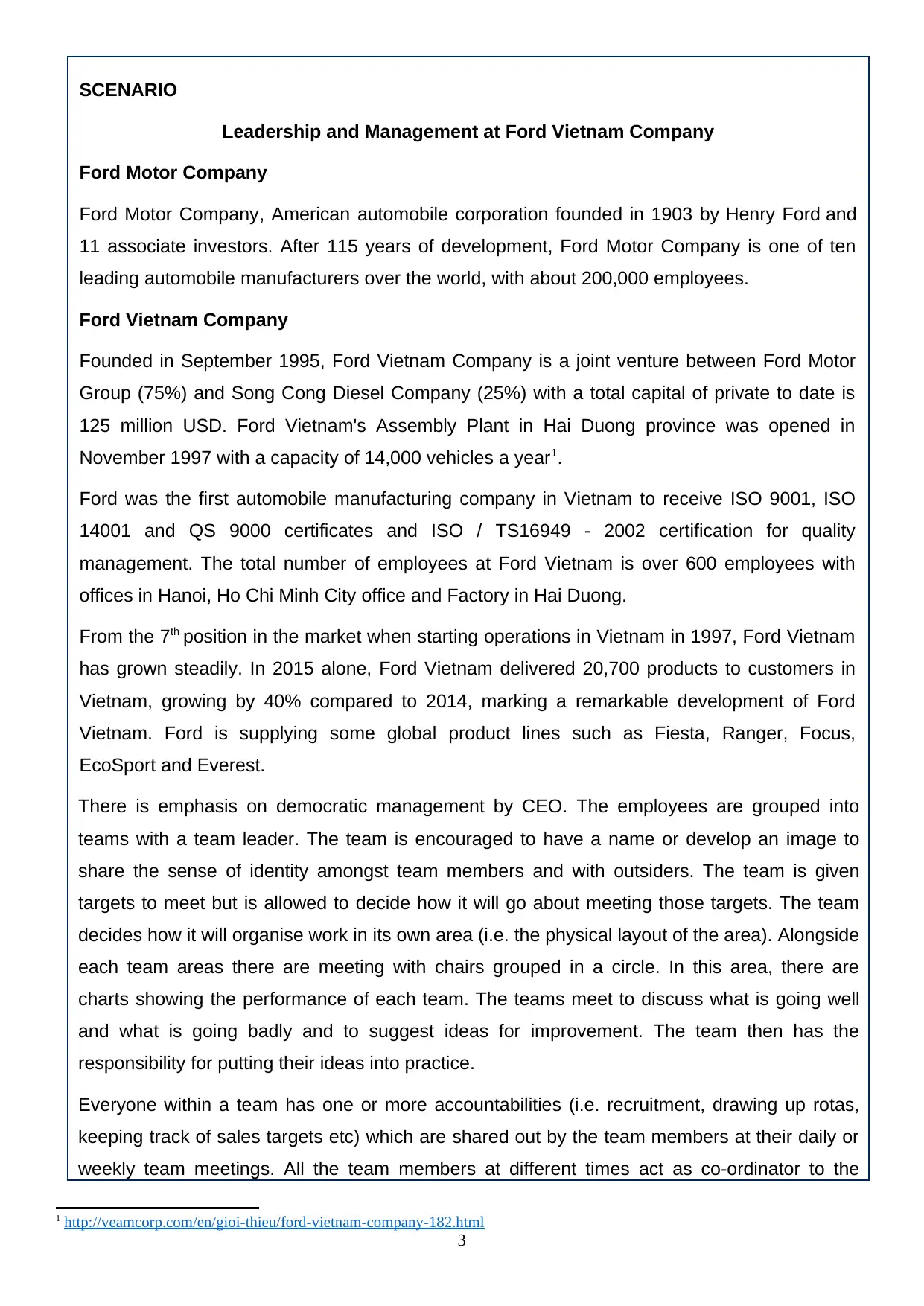
SCENARIO
Leadership and Management at Ford Vietnam Company
Ford Motor Company
Ford Motor Company, American automobile corporation founded in 1903 by Henry Ford and
11 associate investors. After 115 years of development, Ford Motor Company is one of ten
leading automobile manufacturers over the world, with about 200,000 employees.
Ford Vietnam Company
Founded in September 1995, Ford Vietnam Company is a joint venture between Ford Motor
Group (75%) and Song Cong Diesel Company (25%) with a total capital of private to date is
125 million USD. Ford Vietnam's Assembly Plant in Hai Duong province was opened in
November 1997 with a capacity of 14,000 vehicles a year1.
Ford was the first automobile manufacturing company in Vietnam to receive ISO 9001, ISO
14001 and QS 9000 certificates and ISO / TS16949 - 2002 certification for quality
management. The total number of employees at Ford Vietnam is over 600 employees with
offices in Hanoi, Ho Chi Minh City office and Factory in Hai Duong.
From the 7th position in the market when starting operations in Vietnam in 1997, Ford Vietnam
has grown steadily. In 2015 alone, Ford Vietnam delivered 20,700 products to customers in
Vietnam, growing by 40% compared to 2014, marking a remarkable development of Ford
Vietnam. Ford is supplying some global product lines such as Fiesta, Ranger, Focus,
EcoSport and Everest.
There is emphasis on democratic management by CEO. The employees are grouped into
teams with a team leader. The team is encouraged to have a name or develop an image to
share the sense of identity amongst team members and with outsiders. The team is given
targets to meet but is allowed to decide how it will go about meeting those targets. The team
decides how it will organise work in its own area (i.e. the physical layout of the area). Alongside
each team areas there are meeting with chairs grouped in a circle. In this area, there are
charts showing the performance of each team. The teams meet to discuss what is going well
and what is going badly and to suggest ideas for improvement. The team then has the
responsibility for putting their ideas into practice.
Everyone within a team has one or more accountabilities (i.e. recruitment, drawing up rotas,
keeping track of sales targets etc) which are shared out by the team members at their daily or
weekly team meetings. All the team members at different times act as co-ordinator to the
1 http://veamcorp.com/en/gioi-thieu/ford-vietnam-company-182.html
3
Leadership and Management at Ford Vietnam Company
Ford Motor Company
Ford Motor Company, American automobile corporation founded in 1903 by Henry Ford and
11 associate investors. After 115 years of development, Ford Motor Company is one of ten
leading automobile manufacturers over the world, with about 200,000 employees.
Ford Vietnam Company
Founded in September 1995, Ford Vietnam Company is a joint venture between Ford Motor
Group (75%) and Song Cong Diesel Company (25%) with a total capital of private to date is
125 million USD. Ford Vietnam's Assembly Plant in Hai Duong province was opened in
November 1997 with a capacity of 14,000 vehicles a year1.
Ford was the first automobile manufacturing company in Vietnam to receive ISO 9001, ISO
14001 and QS 9000 certificates and ISO / TS16949 - 2002 certification for quality
management. The total number of employees at Ford Vietnam is over 600 employees with
offices in Hanoi, Ho Chi Minh City office and Factory in Hai Duong.
From the 7th position in the market when starting operations in Vietnam in 1997, Ford Vietnam
has grown steadily. In 2015 alone, Ford Vietnam delivered 20,700 products to customers in
Vietnam, growing by 40% compared to 2014, marking a remarkable development of Ford
Vietnam. Ford is supplying some global product lines such as Fiesta, Ranger, Focus,
EcoSport and Everest.
There is emphasis on democratic management by CEO. The employees are grouped into
teams with a team leader. The team is encouraged to have a name or develop an image to
share the sense of identity amongst team members and with outsiders. The team is given
targets to meet but is allowed to decide how it will go about meeting those targets. The team
decides how it will organise work in its own area (i.e. the physical layout of the area). Alongside
each team areas there are meeting with chairs grouped in a circle. In this area, there are
charts showing the performance of each team. The teams meet to discuss what is going well
and what is going badly and to suggest ideas for improvement. The team then has the
responsibility for putting their ideas into practice.
Everyone within a team has one or more accountabilities (i.e. recruitment, drawing up rotas,
keeping track of sales targets etc) which are shared out by the team members at their daily or
weekly team meetings. All the team members at different times act as co-ordinator to the
1 http://veamcorp.com/en/gioi-thieu/ford-vietnam-company-182.html
3
⊘ This is a preview!⊘
Do you want full access?
Subscribe today to unlock all pages.

Trusted by 1+ million students worldwide
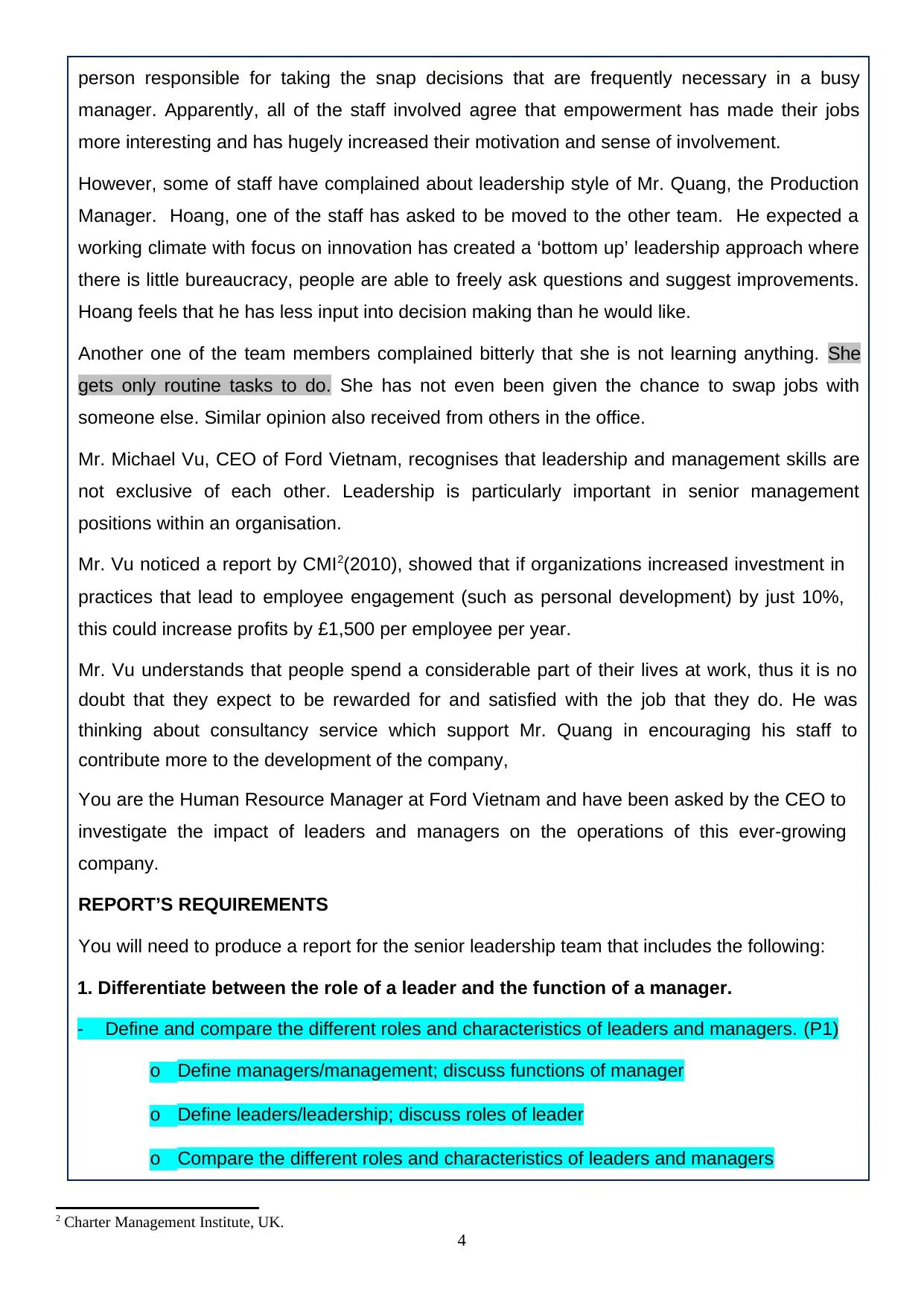
person responsible for taking the snap decisions that are frequently necessary in a busy
manager. Apparently, all of the staff involved agree that empowerment has made their jobs
more interesting and has hugely increased their motivation and sense of involvement.
However, some of staff have complained about leadership style of Mr. Quang, the Production
Manager. Hoang, one of the staff has asked to be moved to the other team. He expected a
working climate with focus on innovation has created a ‘bottom up’ leadership approach where
there is little bureaucracy, people are able to freely ask questions and suggest improvements.
Hoang feels that he has less input into decision making than he would like.
Another one of the team members complained bitterly that she is not learning anything. She
gets only routine tasks to do. She has not even been given the chance to swap jobs with
someone else. Similar opinion also received from others in the office.
Mr. Michael Vu, CEO of Ford Vietnam, recognises that leadership and management skills are
not exclusive of each other. Leadership is particularly important in senior management
positions within an organisation.
Mr. Vu noticed a report by CMI2(2010), showed that if organizations increased investment in
practices that lead to employee engagement (such as personal development) by just 10%,
this could increase profits by £1,500 per employee per year.
Mr. Vu understands that people spend a considerable part of their lives at work, thus it is no
doubt that they expect to be rewarded for and satisfied with the job that they do. He was
thinking about consultancy service which support Mr. Quang in encouraging his staff to
contribute more to the development of the company,
You are the Human Resource Manager at Ford Vietnam and have been asked by the CEO to
investigate the impact of leaders and managers on the operations of this ever-growing
company.
REPORT’S REQUIREMENTS
You will need to produce a report for the senior leadership team that includes the following:
1. Differentiate between the role of a leader and the function of a manager.
- Define and compare the different roles and characteristics of leaders and managers. (P1)
o Define managers/management; discuss functions of manager
o Define leaders/leadership; discuss roles of leader
o Compare the different roles and characteristics of leaders and managers
2 Charter Management Institute, UK.
4
manager. Apparently, all of the staff involved agree that empowerment has made their jobs
more interesting and has hugely increased their motivation and sense of involvement.
However, some of staff have complained about leadership style of Mr. Quang, the Production
Manager. Hoang, one of the staff has asked to be moved to the other team. He expected a
working climate with focus on innovation has created a ‘bottom up’ leadership approach where
there is little bureaucracy, people are able to freely ask questions and suggest improvements.
Hoang feels that he has less input into decision making than he would like.
Another one of the team members complained bitterly that she is not learning anything. She
gets only routine tasks to do. She has not even been given the chance to swap jobs with
someone else. Similar opinion also received from others in the office.
Mr. Michael Vu, CEO of Ford Vietnam, recognises that leadership and management skills are
not exclusive of each other. Leadership is particularly important in senior management
positions within an organisation.
Mr. Vu noticed a report by CMI2(2010), showed that if organizations increased investment in
practices that lead to employee engagement (such as personal development) by just 10%,
this could increase profits by £1,500 per employee per year.
Mr. Vu understands that people spend a considerable part of their lives at work, thus it is no
doubt that they expect to be rewarded for and satisfied with the job that they do. He was
thinking about consultancy service which support Mr. Quang in encouraging his staff to
contribute more to the development of the company,
You are the Human Resource Manager at Ford Vietnam and have been asked by the CEO to
investigate the impact of leaders and managers on the operations of this ever-growing
company.
REPORT’S REQUIREMENTS
You will need to produce a report for the senior leadership team that includes the following:
1. Differentiate between the role of a leader and the function of a manager.
- Define and compare the different roles and characteristics of leaders and managers. (P1)
o Define managers/management; discuss functions of manager
o Define leaders/leadership; discuss roles of leader
o Compare the different roles and characteristics of leaders and managers
2 Charter Management Institute, UK.
4
Paraphrase This Document
Need a fresh take? Get an instant paraphrase of this document with our AI Paraphraser
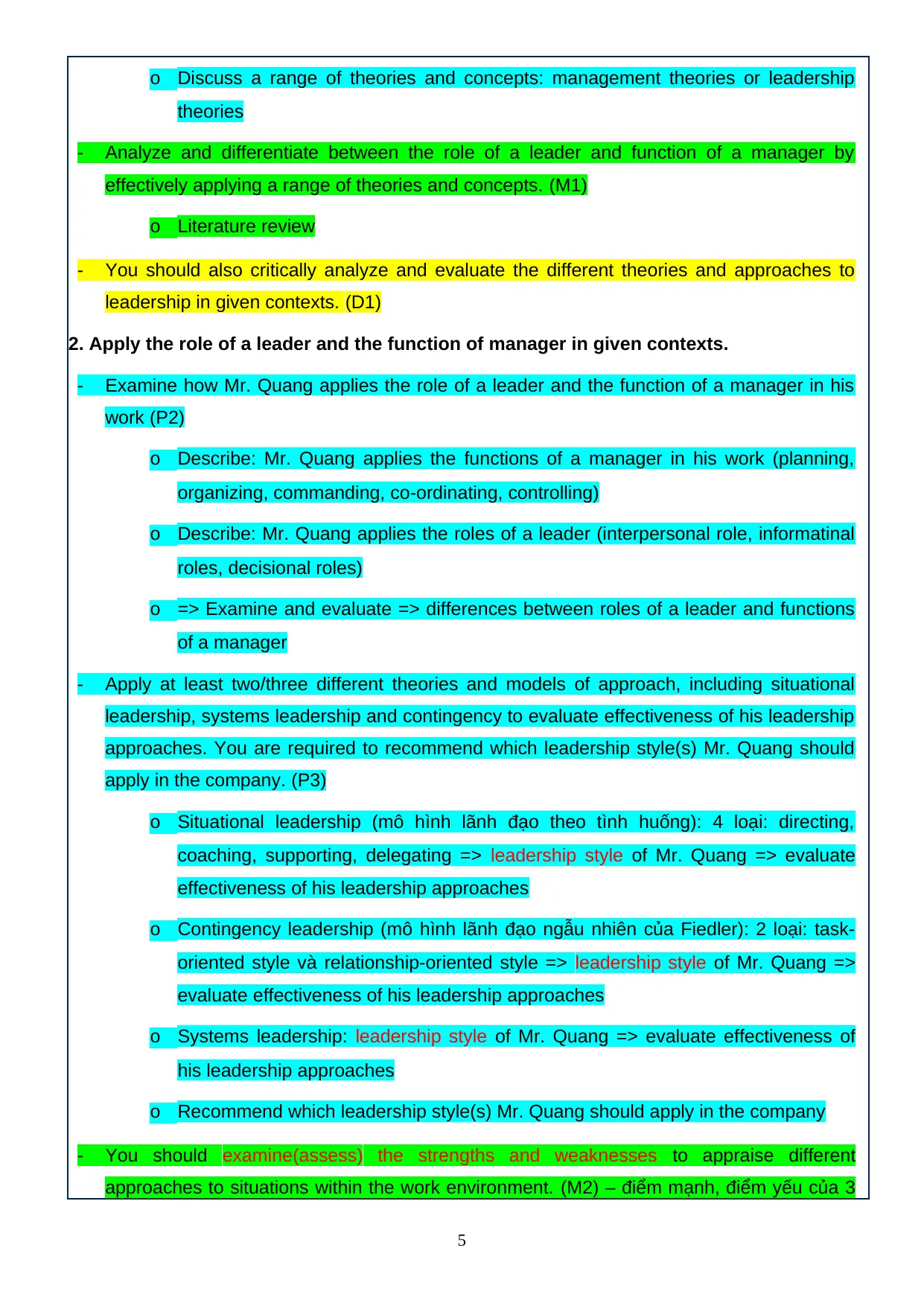
o Discuss a range of theories and concepts: management theories or leadership
theories
- Analyze and differentiate between the role of a leader and function of a manager by
effectively applying a range of theories and concepts. (M1)
o Literature review
- You should also critically analyze and evaluate the different theories and approaches to
leadership in given contexts. (D1)
2. Apply the role of a leader and the function of manager in given contexts.
- Examine how Mr. Quang applies the role of a leader and the function of a manager in his
work (P2)
o Describe: Mr. Quang applies the functions of a manager in his work (planning,
organizing, commanding, co-ordinating, controlling)
o Describe: Mr. Quang applies the roles of a leader (interpersonal role, informatinal
roles, decisional roles)
o => Examine and evaluate => differences between roles of a leader and functions
of a manager
- Apply at least two/three different theories and models of approach, including situational
leadership, systems leadership and contingency to evaluate effectiveness of his leadership
approaches. You are required to recommend which leadership style(s) Mr. Quang should
apply in the company. (P3)
o Situational leadership (mô hình lãnh đạo theo tình huống): 4 loại: directing,
coaching, supporting, delegating => leadership style of Mr. Quang => evaluate
effectiveness of his leadership approaches
o Contingency leadership (mô hình lãnh đạo ngẫu nhiên của Fiedler): 2 loại: task-
oriented style và relationship-oriented style => leadership style of Mr. Quang =>
evaluate effectiveness of his leadership approaches
o Systems leadership: leadership style of Mr. Quang => evaluate effectiveness of
his leadership approaches
o Recommend which leadership style(s) Mr. Quang should apply in the company
- You should examine(assess) the strengths and weaknesses to appraise different
approaches to situations within the work environment. (M2) – điểm mạnh, điểm yếu của 3
5
theories
- Analyze and differentiate between the role of a leader and function of a manager by
effectively applying a range of theories and concepts. (M1)
o Literature review
- You should also critically analyze and evaluate the different theories and approaches to
leadership in given contexts. (D1)
2. Apply the role of a leader and the function of manager in given contexts.
- Examine how Mr. Quang applies the role of a leader and the function of a manager in his
work (P2)
o Describe: Mr. Quang applies the functions of a manager in his work (planning,
organizing, commanding, co-ordinating, controlling)
o Describe: Mr. Quang applies the roles of a leader (interpersonal role, informatinal
roles, decisional roles)
o => Examine and evaluate => differences between roles of a leader and functions
of a manager
- Apply at least two/three different theories and models of approach, including situational
leadership, systems leadership and contingency to evaluate effectiveness of his leadership
approaches. You are required to recommend which leadership style(s) Mr. Quang should
apply in the company. (P3)
o Situational leadership (mô hình lãnh đạo theo tình huống): 4 loại: directing,
coaching, supporting, delegating => leadership style of Mr. Quang => evaluate
effectiveness of his leadership approaches
o Contingency leadership (mô hình lãnh đạo ngẫu nhiên của Fiedler): 2 loại: task-
oriented style và relationship-oriented style => leadership style of Mr. Quang =>
evaluate effectiveness of his leadership approaches
o Systems leadership: leadership style of Mr. Quang => evaluate effectiveness of
his leadership approaches
o Recommend which leadership style(s) Mr. Quang should apply in the company
- You should examine(assess) the strengths and weaknesses to appraise different
approaches to situations within the work environment. (M2) – điểm mạnh, điểm yếu của 3
5
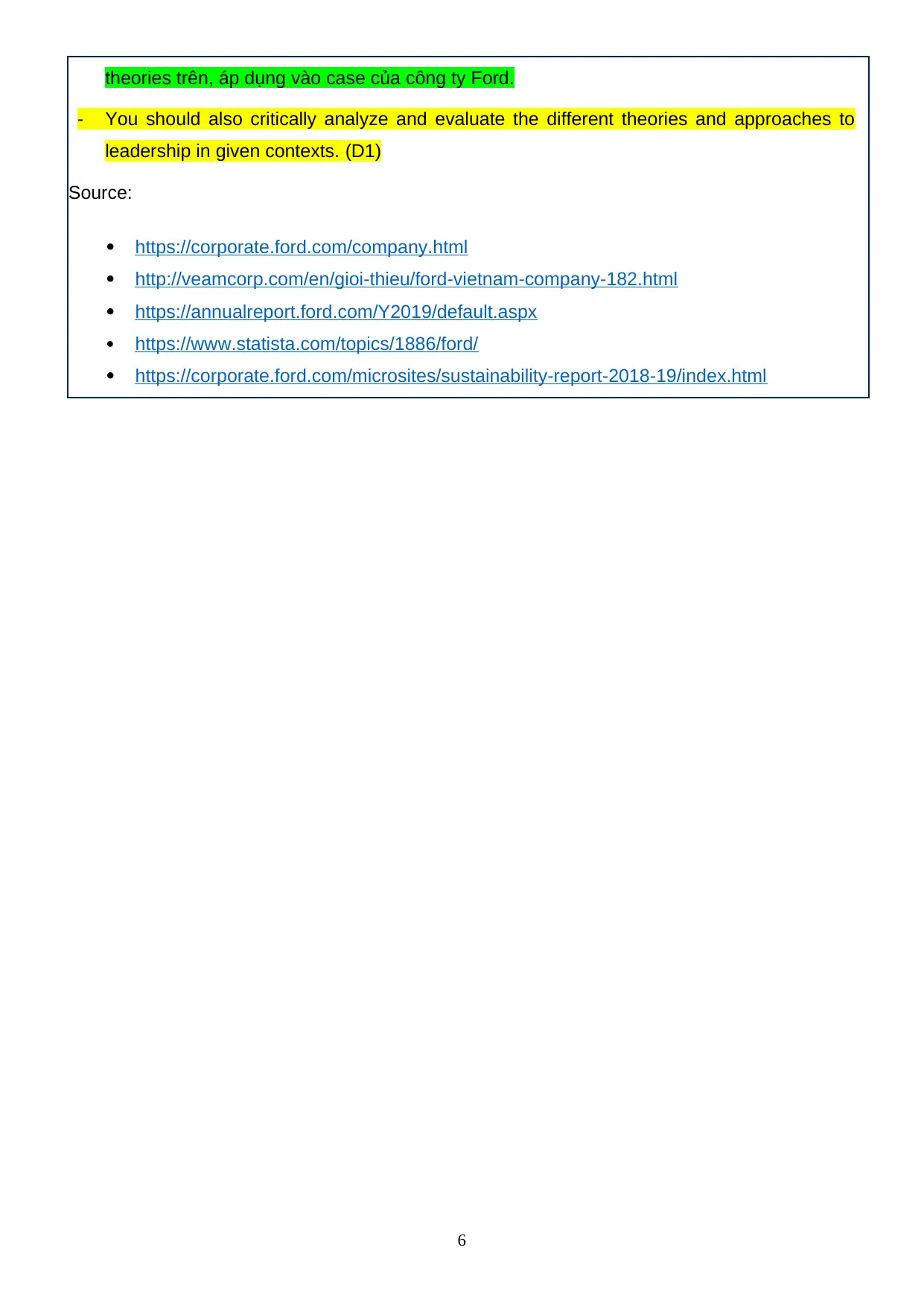
theories trên, áp dụng vào case của công ty Ford.
- You should also critically analyze and evaluate the different theories and approaches to
leadership in given contexts. (D1)
Source:
https://corporate.ford.com/company.html
http://veamcorp.com/en/gioi-thieu/ford-vietnam-company-182.html
https://annualreport.ford.com/Y2019/default.aspx
https://www.statista.com/topics/1886/ford/
https://corporate.ford.com/microsites/sustainability-report-2018-19/index.html
6
- You should also critically analyze and evaluate the different theories and approaches to
leadership in given contexts. (D1)
Source:
https://corporate.ford.com/company.html
http://veamcorp.com/en/gioi-thieu/ford-vietnam-company-182.html
https://annualreport.ford.com/Y2019/default.aspx
https://www.statista.com/topics/1886/ford/
https://corporate.ford.com/microsites/sustainability-report-2018-19/index.html
6
⊘ This is a preview!⊘
Do you want full access?
Subscribe today to unlock all pages.

Trusted by 1+ million students worldwide
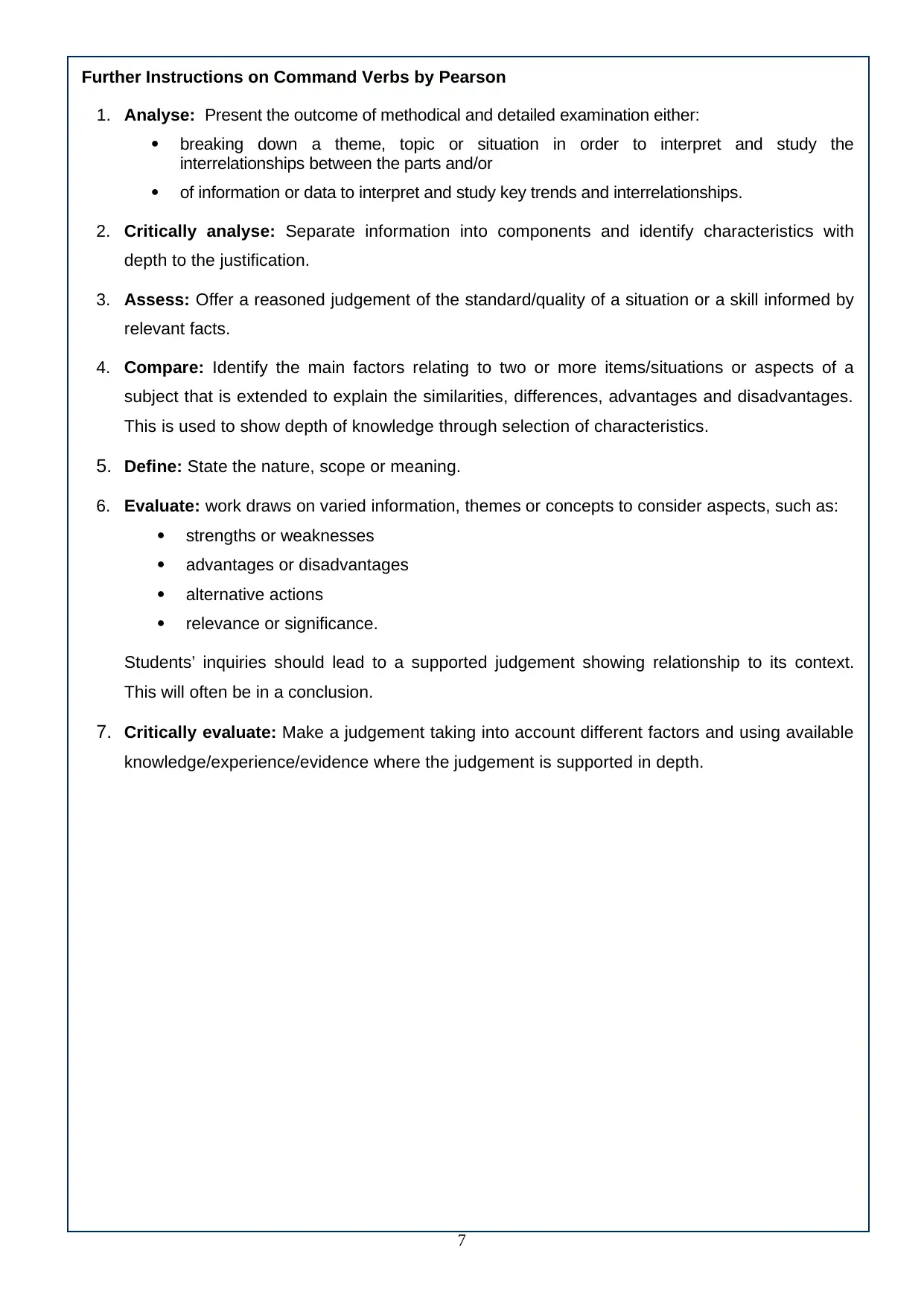
Further Instructions on Command Verbs by Pearson
1. Analyse: Present the outcome of methodical and detailed examination either:
breaking down a theme, topic or situation in order to interpret and study the
interrelationships between the parts and/or
of information or data to interpret and study key trends and interrelationships.
2. Critically analyse: Separate information into components and identify characteristics with
depth to the justification.
3. Assess: Offer a reasoned judgement of the standard/quality of a situation or a skill informed by
relevant facts.
4. Compare: Identify the main factors relating to two or more items/situations or aspects of a
subject that is extended to explain the similarities, differences, advantages and disadvantages.
This is used to show depth of knowledge through selection of characteristics.
5. Define: State the nature, scope or meaning.
6. Evaluate: work draws on varied information, themes or concepts to consider aspects, such as:
strengths or weaknesses
advantages or disadvantages
alternative actions
relevance or significance.
Students’ inquiries should lead to a supported judgement showing relationship to its context.
This will often be in a conclusion.
7. Critically evaluate: Make a judgement taking into account different factors and using available
knowledge/experience/evidence where the judgement is supported in depth.
7
1. Analyse: Present the outcome of methodical and detailed examination either:
breaking down a theme, topic or situation in order to interpret and study the
interrelationships between the parts and/or
of information or data to interpret and study key trends and interrelationships.
2. Critically analyse: Separate information into components and identify characteristics with
depth to the justification.
3. Assess: Offer a reasoned judgement of the standard/quality of a situation or a skill informed by
relevant facts.
4. Compare: Identify the main factors relating to two or more items/situations or aspects of a
subject that is extended to explain the similarities, differences, advantages and disadvantages.
This is used to show depth of knowledge through selection of characteristics.
5. Define: State the nature, scope or meaning.
6. Evaluate: work draws on varied information, themes or concepts to consider aspects, such as:
strengths or weaknesses
advantages or disadvantages
alternative actions
relevance or significance.
Students’ inquiries should lead to a supported judgement showing relationship to its context.
This will often be in a conclusion.
7. Critically evaluate: Make a judgement taking into account different factors and using available
knowledge/experience/evidence where the judgement is supported in depth.
7
Paraphrase This Document
Need a fresh take? Get an instant paraphrase of this document with our AI Paraphraser
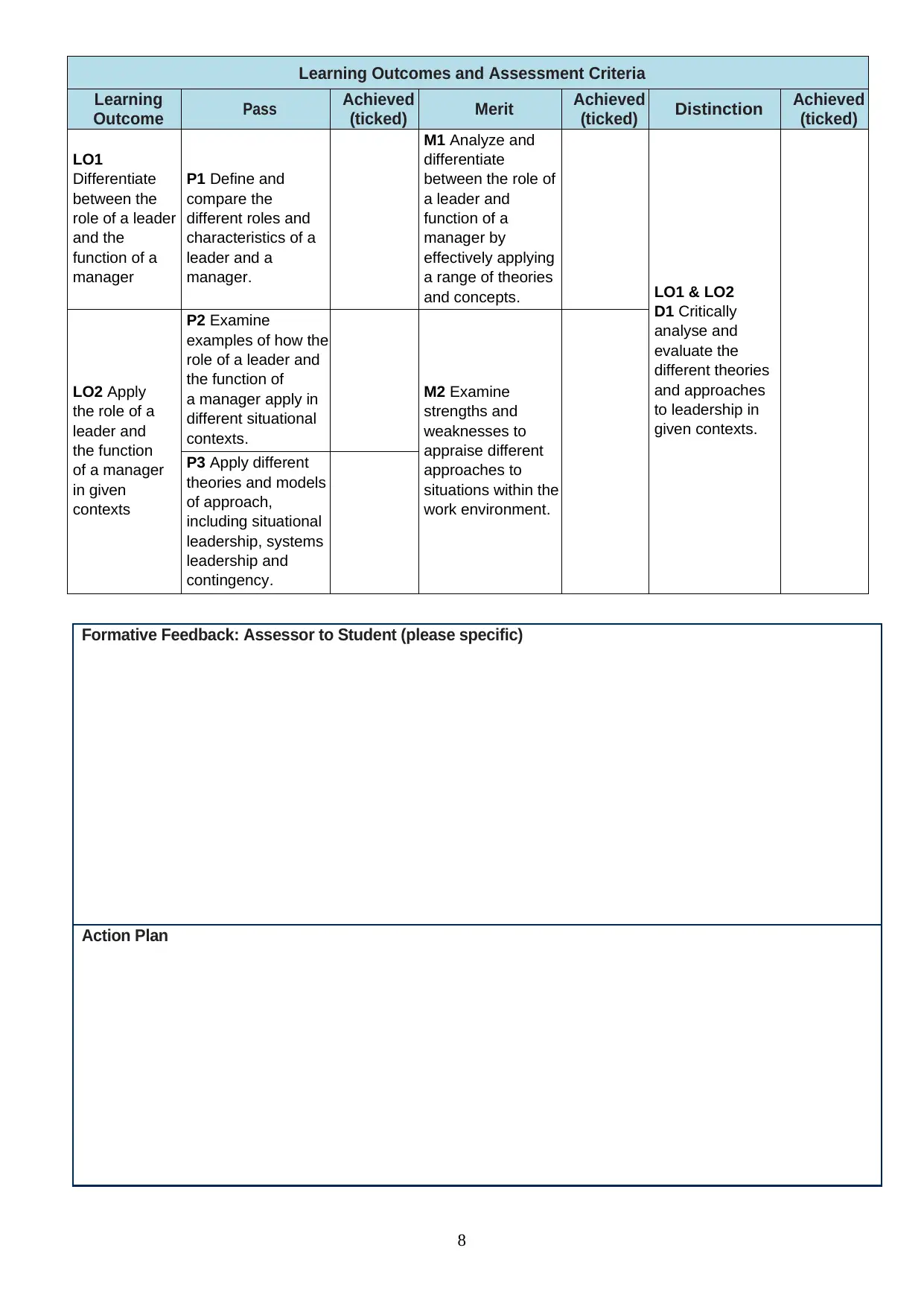
Learning Outcomes and Assessment Criteria
Learning
Outcome Pass Achieved
(ticked) Merit Achieved
(ticked) Distinction Achieved
(ticked)
LO1
Differentiate
between the
role of a leader
and the
function of a
manager
P1 Define and
compare the
different roles and
characteristics of a
leader and a
manager.
M1 Analyze and
differentiate
between the role of
a leader and
function of a
manager by
effectively applying
a range of theories
and concepts. LO1 & LO2
D1 Critically
analyse and
evaluate the
different theories
and approaches
to leadership in
given contexts.
LO2 Apply
the role of a
leader and
the function
of a manager
in given
contexts
P2 Examine
examples of how the
role of a leader and
the function of
a manager apply in
different situational
contexts.
M2 Examine
strengths and
weaknesses to
appraise different
approaches to
situations within the
work environment.
P3 Apply different
theories and models
of approach,
including situational
leadership, systems
leadership and
contingency.
Formative Feedback: Assessor to Student (please specific)
Action Plan
8
Learning
Outcome Pass Achieved
(ticked) Merit Achieved
(ticked) Distinction Achieved
(ticked)
LO1
Differentiate
between the
role of a leader
and the
function of a
manager
P1 Define and
compare the
different roles and
characteristics of a
leader and a
manager.
M1 Analyze and
differentiate
between the role of
a leader and
function of a
manager by
effectively applying
a range of theories
and concepts. LO1 & LO2
D1 Critically
analyse and
evaluate the
different theories
and approaches
to leadership in
given contexts.
LO2 Apply
the role of a
leader and
the function
of a manager
in given
contexts
P2 Examine
examples of how the
role of a leader and
the function of
a manager apply in
different situational
contexts.
M2 Examine
strengths and
weaknesses to
appraise different
approaches to
situations within the
work environment.
P3 Apply different
theories and models
of approach,
including situational
leadership, systems
leadership and
contingency.
Formative Feedback: Assessor to Student (please specific)
Action Plan
8
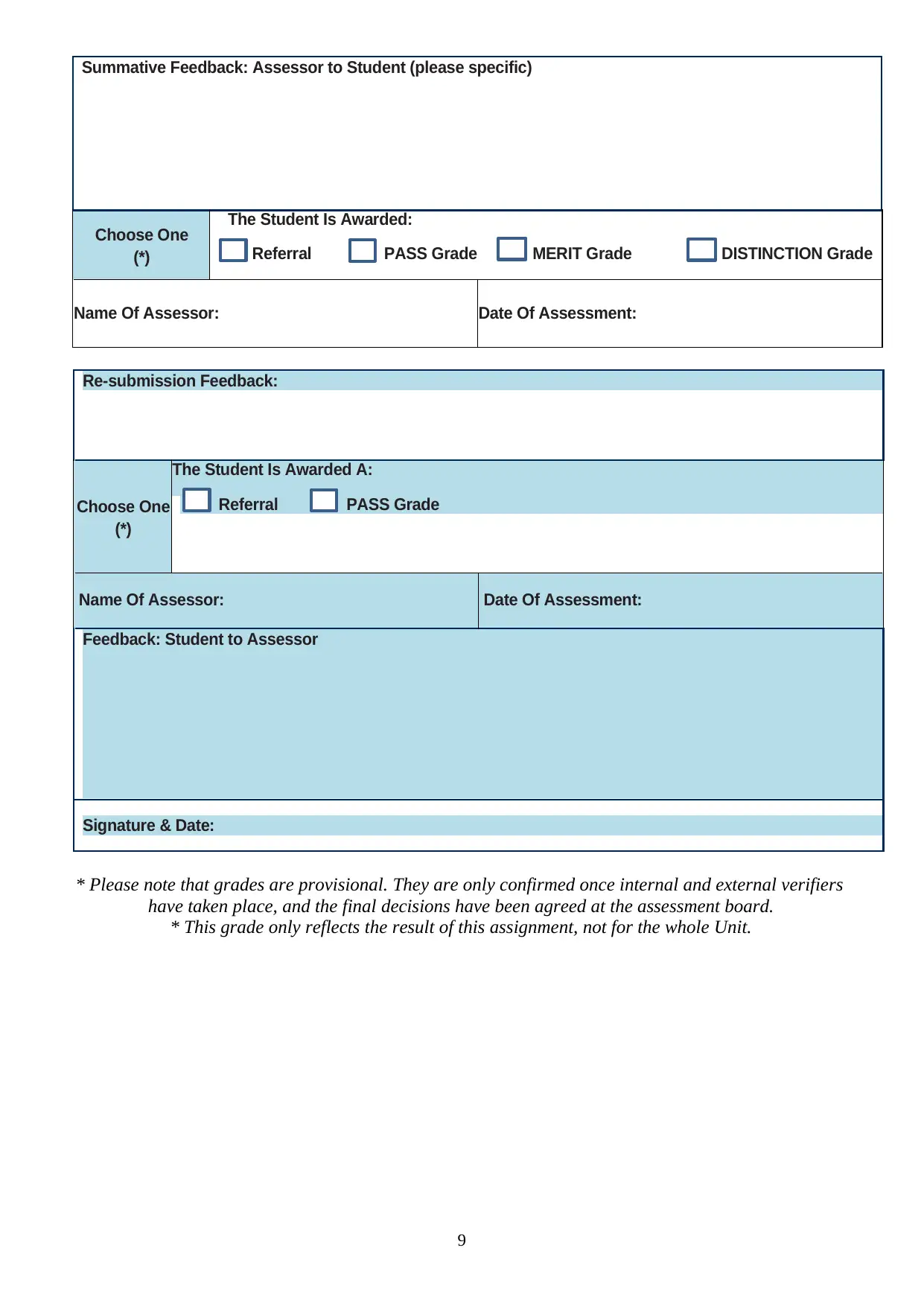
Summative Feedback: Assessor to Student (please specific)
Choose One
(*)
The Student Is Awarded:
Referral PASS Grade MERIT Grade DISTINCTION Grade
Name Of Assessor: Date Of Assessment:
Re-submission Feedback:
Choose One
(*)
The Student Is Awarded A:
Referral PASS Grade
Name Of Assessor: Date Of Assessment:
Feedback: Student to Assessor
Signature & Date:
* Please note that grades are provisional. They are only confirmed once internal and external verifiers
have taken place, and the final decisions have been agreed at the assessment board.
* This grade only reflects the result of this assignment, not for the whole Unit.
9
Choose One
(*)
The Student Is Awarded:
Referral PASS Grade MERIT Grade DISTINCTION Grade
Name Of Assessor: Date Of Assessment:
Re-submission Feedback:
Choose One
(*)
The Student Is Awarded A:
Referral PASS Grade
Name Of Assessor: Date Of Assessment:
Feedback: Student to Assessor
Signature & Date:
* Please note that grades are provisional. They are only confirmed once internal and external verifiers
have taken place, and the final decisions have been agreed at the assessment board.
* This grade only reflects the result of this assignment, not for the whole Unit.
9
⊘ This is a preview!⊘
Do you want full access?
Subscribe today to unlock all pages.

Trusted by 1+ million students worldwide
1 out of 9
Related Documents
Your All-in-One AI-Powered Toolkit for Academic Success.
+13062052269
info@desklib.com
Available 24*7 on WhatsApp / Email
![[object Object]](/_next/static/media/star-bottom.7253800d.svg)
Unlock your academic potential
Copyright © 2020–2025 A2Z Services. All Rights Reserved. Developed and managed by ZUCOL.





